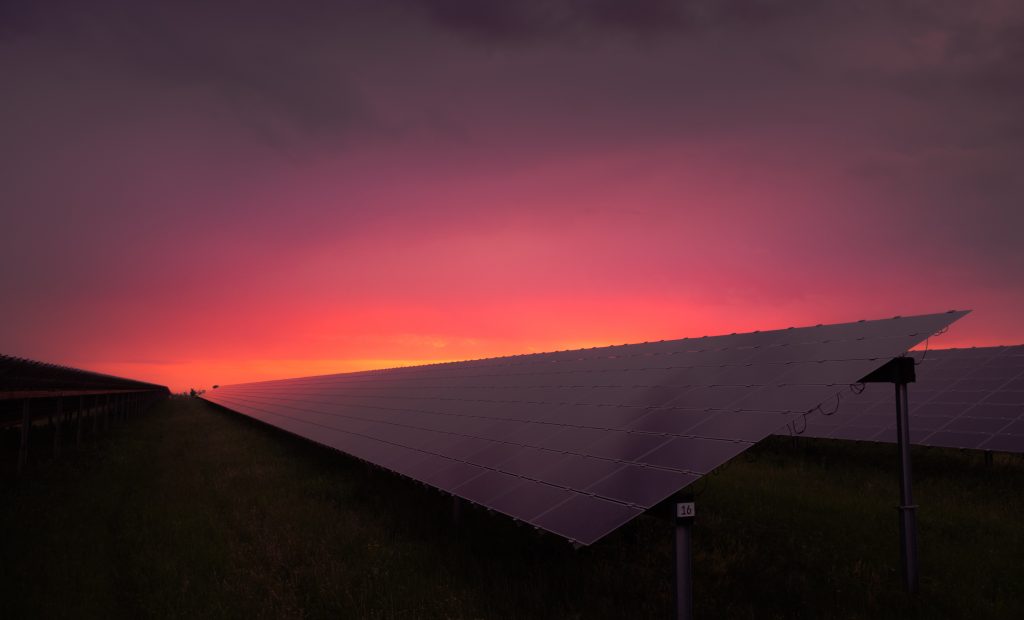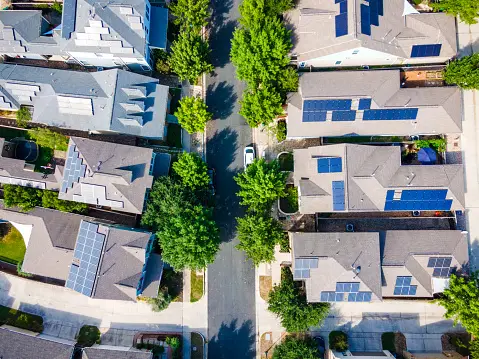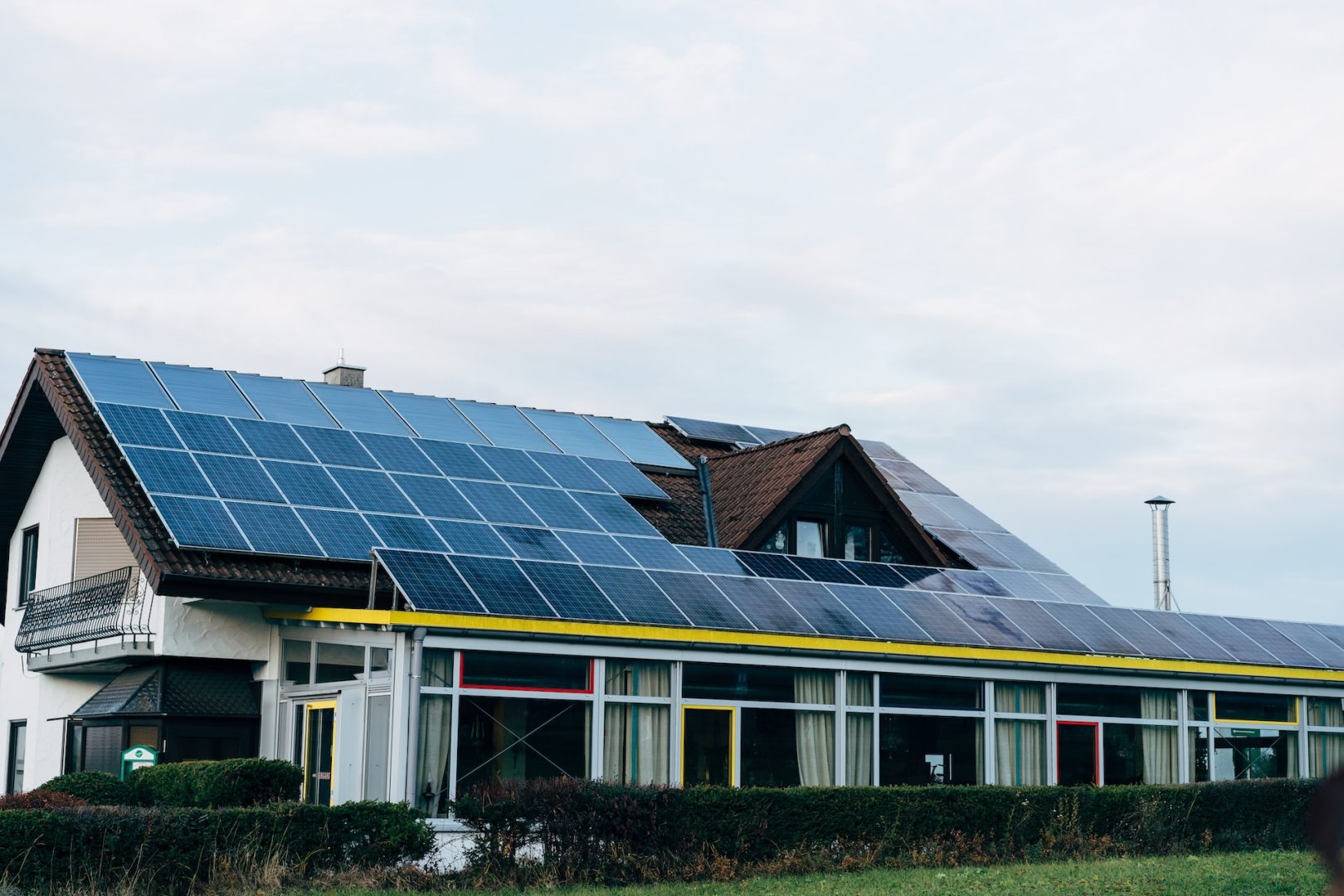In the world of sustainable home design and solar integration, solar-powered homes offer a cozy and eco-friendly haven. You know what they say – home is where the heart is. And who wouldn’t want a home that’s not just cozy but also kind to our planet? Welcome to the realm of solar-powered homes, where the future is bright, and the power is solar!
Your Cozy Oasis with a Solar Twist
Now, here’s where it gets really exciting – the integration of solar power. It’s not just about slapping some solar panels on your roof; it’s about making them a seamless part of your home. The goal? To create a cozy oasis that is both energy-efficient and aesthetically pleasing.
Think about those sleek solar tiles seamlessly blending with your roof or the discreet solar-powered lights illuminating your garden path at night. You’re not just creating a sustainable home; you’re elevating your home’s design.
Why Solar-Powered Homes are the Future
Let’s get down to brass tacks. Why should you consider a solar-powered home? First and foremost, it’s about reducing your carbon footprint. The energy we consume, typically derived from fossil fuels, is a significant contributor to greenhouse gas emissions. Solar energy is clean and sustainable, making it a superhero in the fight against climate change. When you choose solar, you’re choosing a greener, cleaner world.
Solar-powered homes also put more control in your hands. By generating your electricity, you can manage your energy consumption and costs more efficiently. Plus, with the right systems in place, you might even produce excess energy to sell back to the grid.
Brightening Your Life and Your Wallet
Now, you might be thinking, “Sure, solar sounds great for the planet, but what’s in it for me?” Well, apart from the warm, fuzzy feeling of reducing your environmental impact, solar integration can lead to significant savings. Solar panels can pay for themselves over time by reducing your electricity bills.
But wait, there’s more! In some regions, governments offer incentives and tax breaks for homeowners who invest in solar energy. Plus, you’ll likely see an increase in your property value. It’s a smart financial choice that’s also fantastic for the Earth.
Tailoring Solar Integration to Your Home

You’re probably wondering, “How can I integrate solar power into my home?” The possibilities are as diverse as home designs themselves. Here are a few ideas to get your creative gears turning:
- Solar Panels: This is the classic choice. Install photovoltaic panels on your roof to convert sunlight into electricity. These can power your home, and any excess energy can be fed back into the grid.
- Solar Water Heaters: Say goodbye to high water heating bills. Solar water heaters use the sun’s energy to warm your water supply.
- Solar-Powered Lights: Illuminate your outdoor spaces with solar-powered lights. They charge during the day and light up your garden, pathway, or patio at night.
- Solar Roof Tiles: If you’re particular about aesthetics, solar roof tiles blend seamlessly with your existing roofing material, maintaining your home’s curb appeal.
- Solar Ventilation: Keep your home cool with solar-powered attic fans. They reduce your energy consumption and help prolong your roof’s life.
- Solar Chargers: From smartphones to electric cars, solar chargers can power your gadgets and vehicles using clean energy.
- Solar Home Batteries: Store excess energy during the day to use at night or during power outages. Battery technology is advancing rapidly, making this option increasingly attractive.
- Solar Greenhouses: If you have a green thumb, why not power your greenhouse with the sun? It’s a game-changer for year-round gardening.
Energy-Efficient Appliances and Solar Synergy
Welcome to the power-packed world of energy-efficient appliances and solar synergy! When it comes to turning your house into an energy-efficient haven, it’s all about those smart, eco-friendly choices. Let’s dive in and explore how combining these energy-saving champs with solar power can revolutionize your home.
The Dream Team: Energy-Efficient Appliances
You’ve heard the buzz about energy-efficient appliances, but do you know why they’re such a big deal? Well, imagine your home filled with appliances that consume less energy, reduce your bills, and save the planet. That’s the magic of energy-efficient appliances.
From refrigerators and washing machines to LED lighting and smart thermostats, these appliances are engineered to make every watt count. They’re not just better for your wallet; they’re better for the environment. But here’s where it gets even more exciting – when you pair them with solar power, you’ve got yourself a match made in energy heaven.
Why Energy Efficiency Matters
Before we delve into the beautiful synergy between energy-efficient appliances and solar power, let’s understand why energy efficiency matters. In a world where energy consumption is at an all-time high, we’re stretching our resources thin and hurting our planet. But it doesn’t have to be this way.
Energy-efficient appliances consume less energy, but they don’t compromise on performance. They’re designed to do the same tasks, if not better, while using fewer resources. This reduces your energy bills, eases the burden on power plants, and decreases harmful emissions. It’s a win-win situation for everyone involved.
Solar-Powered Homes: The Future Is Here
Now, picture this: your energy-efficient appliances powered by the sun. It’s not just a pipe dream; it’s a growing reality. Solar-powered homes are becoming increasingly common, and they’re transforming the way we use and think about energy. So, how does it work?
Solar panels, typically installed on your roof, capture sunlight and convert it into electricity. This electricity can power your home, charge your energy-efficient appliances, and more. What’s remarkable is that you can harness the sun’s energy during the day and store excess energy for use at night. It’s like having your personal power plant on your rooftop but without the environmental footprint.
Energy-Efficient Appliances and Solar Synergy: A Perfect Match
Now that you understand the significance of energy-efficient appliances and the potential of solar-powered homes, let’s talk about how they can work together seamlessly.
- Reduced Energy Bills: Energy-efficient appliances already save you money by using less electricity. When paired with solar power, your energy bills can plummet even further. You can potentially generate more energy than you need during the day, allowing you to sell excess energy back to the grid or store it for later use.
- Environmental Impact: Every kilowatt-hour you save with energy-efficient appliances is a kilowatt-hour less power plants need to produce. When you add solar energy into the equation, your home becomes a hub of green, clean energy. You’re significantly reducing your carbon footprint and helping combat climate change.
- Energy Independence: With energy-efficient appliances and solar panels, you’re no longer at the mercy of fluctuating energy prices or power outages. You’re in control of your energy production and consumption. Imagine a blackout in your neighborhood while your home remains well-lit, all thanks to your trusty solar panels.
- Long-Term Savings: The initial investment in energy-efficient appliances and solar panels pays off in the long run. Not only do you save on monthly bills, but you’ll also increase the value of your home. Many homebuyers are willing to pay a premium for a house equipped with these eco-friendly features.
Choosing the Right Appliances for Solar-Powered Homes

It’s important to choose energy-efficient appliances that align with your solar power system. Here are some essential tips to consider:
- Energy Star Ratings: Look for the Energy Star label when purchasing appliances. These products meet strict energy efficiency guidelines and are a great fit for solar-powered homes.
- Sizing Matters: When selecting appliances like air conditioners or heating systems, ensure they are appropriately sized for your home. Oversized appliances can waste energy.
- Smart Technology: Opt for appliances with smart technology. They can communicate with your solar inverter, allowing you to schedule energy-intensive tasks when the sun is shining its brightest.
- Energy Consumption: Pay attention to the energy consumption of each appliance. It’s usually measured in kilowatt-hours (kWh). Lower kWh ratings mean less energy usage.
Solar Heating and Cooling Systems
Are you tired of high energy bills and environmental concerns lurking behind your heating and cooling systems? Well, it’s time to discover the magic of solar heating and cooling. Get ready to cozy up or chill out in the most energy-efficient and eco-friendly way possible.
Heating Up the Solar Story
When you think of solar power, you might picture solar panels gleaming on a sun-drenched rooftop. But what if we told you that solar energy can also keep you toasty in the winter? That’s right; solar heating systems are here to revolutionize the way you keep warm.
Solar heating systems, also known as solar thermal systems, capture the sun’s energy and convert it into heat. The magic happens through solar collectors, typically installed on your roof. These collectors absorb sunlight, which is then used to heat water or a heat-transfer fluid. The result? A cozy home heated by the power of the sun.
How Solar Heating Works for You
Imagine waking up on a chilly winter morning, knowing your home is being heated by clean, renewable energy. Solar heating systems offer numerous benefits:
- Cost Savings: Once you’ve installed a solar heating system, your energy bills will feel the relief. You’re harnessing free sunlight to heat your home, reducing your dependence on fossil fuels.
- Sustainability: Solar heating is a sustainable way to keep your home warm. It’s environmentally friendly, emitting no greenhouse gases or harmful pollutants. You’re contributing to a greener planet.
- Energy Independence: With a solar heating system, you’re not at the mercy of fluctuating energy prices. You’re in control of your heat production, even during power outages.
- Renewable Heat: Solar energy is an abundant and renewable resource. Unlike finite fossil fuels, the sun isn’t going anywhere soon.
Cooling Down the Solar Scene

Now that we’ve warmed up, let’s dive into the cool side of solar heating and cooling. Just like solar heating systems, solar cooling systems offer an energy-efficient and eco-friendly way to keep your home comfortable.
Solar cooling systems use solar energy to provide air conditioning or cooling for your home. The process is somewhat like magic – it uses solar energy to power absorption chillers, which cool your home’s air. It’s not just about staying cool; it’s about staying cool while saving on energy.
The Sunshine Benefits of Solar Cooling
Solar cooling systems aren’t just about enjoying a chilled living space. They offer a plethora of sunny advantages:
- Energy Efficiency: Solar cooling systems are highly energy-efficient. They can reduce your cooling costs and reliance on conventional, energy-hungry cooling methods.
- Sustainability: Just like solar heating, solar cooling is sustainable and eco-friendly. It significantly reduces your carbon footprint, helping combat climate change.
- Reliability: Solar cooling systems can provide cooling even during power outages. You’re not left sweltering when the grid goes down.
- Cost Savings: While there’s an initial investment in installing a solar cooling system, the long-term savings and reduced energy bills make it a wise choice for budget-conscious homeowners.
The Right Balance for Solar-Powered Homes
As you explore the world of solar-powered homes, finding the right balance between solar heating and cooling systems is essential. Furthermore, the key is to create a harmonious synergy between these systems to ensure year-round comfort, cost savings, and sustainability.
Here are some tips for achieving the perfect balance:
- System Sizing: Ensure your solar heating and cooling systems are appropriately sized for your home. Oversized systems can lead to inefficiencies and unnecessary expenses.
- Smart Technology: Invest in systems that incorporate smart technology. These systems can automatically adjust to optimize your home’s temperature, ensuring comfort and energy savings.
- Routine Maintenance: Regular maintenance is crucial to keep your solar systems in peak condition. Ensure you schedule inspections and cleanings as recommended by the manufacturer.
Achieving Net-Zero Energy Homes with Solar
Imagine a home where your energy bills are close to zero, your carbon footprint is minimal, and your comfort knows no bounds. In short, the beauty of net-zero energy homes, and solar power plays a starring role in this sustainable dream.
What is a Net-Zero Energy Home?
Before we dive into the solar-powered magic, let’s understand what a net-zero energy home is all about. A net-zero energy home generates as much energy as it consumes over a year. In simple terms, it’s a home that balances the energy scales to achieve a near-zero energy bill.
Solar Panels: Your Green Energy Factory
Now, let’s talk about the star of the show – solar panels. These sleek, photovoltaic wonders are like mini power plants on your rooftop. They convert sunlight into electricity and make your net-zero energy dreams come true.
When the sun graces your solar panels with its rays, something remarkable happens. The solar panels work their magic and generate electricity. This electricity can be used to power your home’s lights, appliances, and heating or cooling systems.
Becoming a Solar-Powered Homeowner
The journey to becoming a solar-powered homeowner and achieving net-zero energy starts with solar panel installation. When it comes to going solar, you have two main options:
- Grid-Tied Solar Systems: These systems are connected to your local electric grid. When your solar panels produce more electricity than your home needs, the excess flows back into the grid, earning you credits. On cloudy days or at night, you can still draw power from the grid.
- Off-Grid Solar Systems: Off-grid systems are for those seeking complete energy independence. They rely on batteries to store excess solar energy for use when the sun isn’t shining. You won’t receive electricity bills, but the initial setup can be more complex.
Solar Batteries: Energy Storage Heroes
The key to achieving net-zero energy and enjoying 24/7 power availability is energy storage. Solar batteries are the unsung heroes in your solar-powered home. These batteries store excess electricity generated during the day so you can use it at night or when the sun isn’t shining.
With solar batteries, your home stays powered even during power outages. It’s like having a personal energy vault that keeps your lights on, your appliances running, and your comfort uninterrupted.
The Benefits of Solar-Powered Net-Zero Energy Homes

Imagine a life where energy bills are a distant memory, where your carbon footprint is lighter than ever, and where you have uninterrupted power. The benefits of solar-powered net-zero energy homes are truly something to behold:
- Cost Savings: Your energy bills dwindle, and you may even receive credits from the excess electricity you feed back into the grid. Over time, the savings can be substantial.
- Environmental Impact: By reducing your reliance on fossil fuels and embracing clean, renewable solar energy, you’re contributing to a greener planet. Your carbon footprint shrinks as your solar panels work their magic.
- Energy Independence: With solar power and batteries, you’re less dependent on the grid. You have a reliable source of energy that can keep your home running, even during power outages.
- Comfort and Convenience: Net-zero energy homes are equipped with all the comforts and conveniences you’d expect. You enjoy the same appliances, heating, cooling, and lighting, but with a smaller environmental impact.
Challenges and Considerations
While the idea of net-zero energy homes powered by solar is enticing, it’s not without its considerations and challenges:
- Upfront Costs: Solar panel installation and battery systems require an initial investment. However, many governments and utilities offer incentives and rebates to ease the financial burden.
- System Sizing: It’s crucial to size your solar panel and battery systems correctly to meet your energy needs. Oversized or undersized systems can lead to inefficiencies.
- Maintenance: Solar panels and batteries require regular maintenance to ensure they function optimally. Cleaning panels and checking batteries are essential tasks.
Conclusion
This article delves into the concept of sustainable home design and its seamless integration with solar technologies. It emphasizes the numerous benefits of incorporating solar power into homes and explores a wide array of options for solar integration. These options include solar panels, solar water heaters, solar-powered lights, solar roof tiles, solar ventilation, solar chargers, solar home batteries, and solar greenhouses. To create a smoother transition, the article goes on to underscore the significance of energy-efficient appliances when used in conjunction with solar power. These appliances are pivotal in reducing energy bills and minimizing environmental impact.
Furthermore, the article delves into the realm of solar heating and cooling systems, shedding light on how these systems can bring about substantial cost savings and enhanced sustainability. It then segues into the exciting concept of net-zero energy homes, which are designed to generate as much energy as they consume over the course of a year. In this context, solar panels and solar batteries play a pivotal role in achieving net-zero energy, enabling homeowners to enjoy a myriad of benefits, including significant cost savings, reduced environmental impact, enhanced energy independence, and continued comfort.
To maintain a balanced perspective, the article also takes into account the challenges and considerations associated with solar-powered net-zero energy homes. These include the initial upfront costs of solar panel installation and battery systems, the importance of correctly sizing these systems, and the necessity of regular maintenance for optimal functionality.

